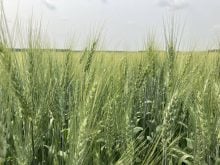ALBERTA
SOUTH
Rain hampers crops
Rain showers during the past week have increased moisture reserves, which now range from excellent to excessive. The rain has also hampered crop development. It’s estimated crops are 10 to 20 days behind normal. Oilseed and pulses are flowering and spring seeded cereals are headed out. The first crop of haying is well underway with above average yields. There is difficulty getting the hay baled.
CENTRAL
Crop behind
Read Also

Gap in emission regulations hamstrings Canadian hybrid truck manufacturer
A B.C. company building hybrid engines for heavy trucks says they have the opportunity to build something leading edge in Canada, but our own laws are stopping them from doing it.
Thirty to 100 millimetres of precipitation have fallen in the past two weeks, with heavy rain reported in Red Deer, Lacombe, Ponoka and Stettler. Soil moisture conditions range from good to excessive. Crop development is seven to 10 days behind normal. Warm temperatures have given a boost to most crops, especially canola. Good moisture conditions have given pasture and tame hay a boost but have reduced quality of hay in the swath.
NORTHWEST
Crop lagging
Rain across the region pushed soil moisture reserves to adequate. The region has not received the same amount of rain as the rest of the province. Some areas have received excess moisture and water is lying in parts of the fields. Crops are mostly in good condition, but development is a week to 10 days behind normal. Spring wheat is generally rated as good. Canola is rated as good.
NORTHEAST
Warm weather welcome
Up to 100 mm of rain have fallen in some parts of the region over the past two weeks, creating small lakes in some low-lying fields. Soil moisture is rated as good to excessive. Warm weather has given crops a boost, but crop development remains seven to 10 days behind normal. Hailstorms have caused some damage. Pasture land is generally rated as excellent.
PEACE &B.C.
Dry conditions persist
Scattered rain showers have mostly been teasers. Less than 20 mm of rain have fallen across parts of the northern area. Dry conditions remain a concern and rain is badly needed. Crop conditions have deteriorated in the south and central areas. Spring wheat is rated as 20 percent poor, 35 percent fair, 41 percent good and four percent excellent. Canola is rated as 22 percent poor, 34 percent fair, 39 percent good and five percent excellent. Pasture growth has been slow and is reported as 60 percent poor.
MANITOBA
SOUTHWEST
Crops drying
Warmer weather helped to dry some crops. Early cereals are filling, later seeded cereals are tillering. Fusarium is also showing up.
CENTRAL &RED RIVER VALLEY
Hail damage
Hail and high winds caused crop damage southwest of Morden and in the Manitou-Darlingford areas, with localized damage as high as 100 percent in some fields.
INTERLAKE
Water persists
Water remains in low lying areas. Early seeded canola has finished flowering. Warm season crops, such as sunflowers and corn, continue rapid development as a result of the recent long, hot days.
NORTHWEST
Crops developing
Cereals have almost completed flowering. About 30 percent of wheat is in early dough stages. Canola is advancing through late flowering with around 30 percent podding. General crop conditions and development are most favourable through the Roblin, Swan River and The Pas areas.
EASTERN
Fields recovering
Crop uniformity is better in the southern areas where less precipitation has fallen. In other areas, uneven development will be an issue. Many fields are recovering from excess moisture but are showing yield reductions in low areas. Spring wheat and oat fields are 100 percent headed out with good yield potential.
SASKATCHEWAN
SOUTHWEST
Local showers
Little rain fell throughout the region over the week. Some thundershowers near Moose Jaw caused problems but were generally localized. Topsoil moisture is rated as surplus to adequate. Crop damage has been caused by hail, grasshoppers and gophers. Leaf disease and root rot are also starting to cause problems. .
SOUTHEAST
Rain eases
Scattered showers fell throughout the region, but farmers were generally breathing a sigh of relief that fewer showers came through the area. Topsoil moisture conditions are generally adequate on hay and crop land. Crop damage is mainly attributed to flooding, hail and leaf disease. Grasshoppers are causing problems in some areas.
WEST-CENTRAL
Thunderstorms hit
Thunderstorms caused wind, hail and heavy rain in some areas. About 40 percent of the area is considered to have surplus moisture. The majority of crop damage is due to flooding and wind. Leaf disease and grasshoppers are causing damage. There are also reports of bertha armyworms and sclerotinia in canola crops and grasshoppers in lentils. Haying continues.
EAST-CENTRAL
Flooding major problem
Spotty showers and thunderstorms were reported over the past week. The region has now received 233 to 619 mm of rain. Sixty-five percent of topsoil moisture is rated as surplus. Flooding continues to be the cause of the majority of crop damage. Leaf diseases are starting to show up.
NORTHWEST
Weather damage
Thunderstorms and hail storms created havoc on farms over the past week, especially around the North Battleford area. Crop damage was mostly attributed to flooding, hail and wind damage. Farmers are struggling to hay. Most of the hay is still standing or cut and rotting.
NORTHEAST
Topsoil saturated
Rain continued. Topsoil moisture is considered surplus in 75 percent of the acres. Hay land and pasture land topsoil moisture is also considered surplus or adequate. Much of the crop damage is due to flooding, hail and wheat midge. Farmers continue to hay but find it difficult due to heavy swaths and continual rain.














